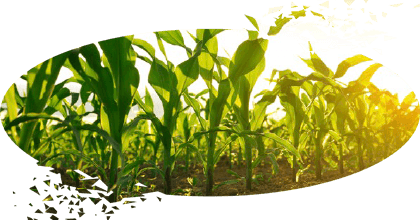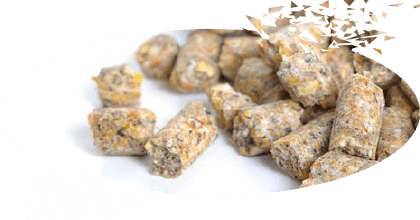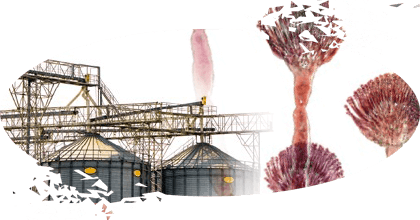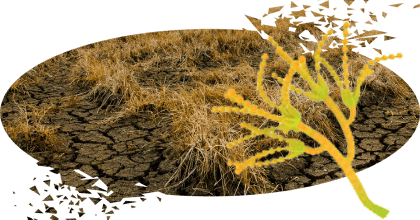Dr. Rui Alexandre Gonçalves
Aquaculture and Mycotoxin Expert
Email: [email protected]
The threat that mycotoxins pose to the agricultural and animal feed industries is well characterized. However, Climate Change entails a new threat to agricultural commodities, shifting the way we look at mycotoxin risk assessment.
![]() Rising temperatures, extreme weather, and abnormal variations in rainfall are new challenges for crop management but also for animal farmers.
Rising temperatures, extreme weather, and abnormal variations in rainfall are new challenges for crop management but also for animal farmers.


To understand the potential impact of Climate Change on mycotoxin crop/feed contamination, firstly, it is important to understand:
- ⇰ Why are mycotoxins produced?
- ⇰ How do they get into animal feed?
Then, we can try to understand how Climate Change may add some additional challenges to the current mycotoxin management protocols and how, in some cases, we may need to readjust our approach to mycotoxin management in the future.
How and why are mycotoxins produced by fungi?
Those who are already familiar with the topic will be aware that the exact process of mycotoxin production by fungi is not fully understood.
It is hypothesized that producing mycotoxins may be a strategy to outcompete other microorganisms for access to plant nutrients (Rankin y Grau, 2002).
Another explanation given by Khaneghal et al. (2018), who studied the effects of DON on the host plant, postulates that the production of DON prevents the formation of a thick cell wall, which facilitates fungal infection.
The most studied mycotoxins (deoxynivalenol -DON-, aflatoxins -AFs-, fumonisins -FUM-, zearalenone -ZEN-, and ochratoxin A -OTA-) are produced by merely a few species from the common genera Aspergillus, Penicillium, and Fusarium.
These species can be simplistically categorized as field fungi (Fusarium), which infect crops as parasites, and storage fungi (Aspergillus and Penicillium), which grow in feedstuffs stored under suboptimal conditions.
![]() The main factor that determines this simple classification is the moisture levels of the host. Understanding this point is fundamental to estimating possible future Climate Change impacts.
The main factor that determines this simple classification is the moisture levels of the host. Understanding this point is fundamental to estimating possible future Climate Change impacts.
Field fungi, such as Fusarium spp., generally require higher moisture levels (>0.9 water activity) to grow and produce mycotoxins. Therefore, they mainly infect seeds and plants in the field.
Storage fungi, such as Aspergillus spp. and Penicillium spp., have lower water activity (aw) requirements and are, thus, more predominant after harvest and during storage.

It is important to know that all Aspergillus spp. and Penicillium spp. species are commensals, which means they can grow on crops without obvious signs of pathogenicity, but can also invade crops after harvest, producing toxins during the drying and storage stages.
Nowadays, the most important Aspergillus species, occurring in warmer climates, are A. flavus and A. parasiticus.
Some common exceptions to this simplistic rule of thumb are:
- ⇰ Penicillium verrucosum also produces OTA, but only in cool temperate climates where it infects small grains.
- ⇰ Fusarium verticillioides, ubiquitous in maize with an endophytic nature, produces FUM and is generally more prevalent when crops are subjected to drought stress or suffer excessive insect damage.

Delving into how mycotoxins are produced, it is important to understand the biological characteristics of fungi.
Fungal growth and the occurrence of individual mycotoxins is a result of a complex interaction of several factors among which environmental conditions (geography and climatic factors) are the most relevant (Kuiper-Goodman, 2004; Miraglia et al., 2009; Paterson y Lima, 2010; Paterson y Lima, 2011; Ramírez et al., 2006).
![]() Closely related to these two main factors (geography and climatic factors), biological requirements, namely, temperature and water activity (aw) play a critical role in fungal growth and consequent mycotoxin production (CAST, 2003; FAO, 2004; Marth, 1992; Ramírez et al., 2006; Sweeney y Dobson, 1998).
Closely related to these two main factors (geography and climatic factors), biological requirements, namely, temperature and water activity (aw) play a critical role in fungal growth and consequent mycotoxin production (CAST, 2003; FAO, 2004; Marth, 1992; Ramírez et al., 2006; Sweeney y Dobson, 1998).
However, fungal growth and mycotoxin production are not just the result of simple combinations of optimal temperature and water activity. The host’s health status (i.e., the plant) is a very influential factor that will be greatly impacted by climate change.

Returning to the biological requirements of fungi and taking F. graminearum as an example, several studies from root and stalk rot of cereals have shown that the optimum water content and temperature for fungal growth were 0.99–0.98 aw at 20–30°C changing to 0.95–0.96 aw at 35°C (Ramirez et al., 2004).
Interestingly, in 2006, the same author (Ramirez et al., 2006) observed that, while growth was optimum at 25°C, mycotoxin production was optimum at 30°C.
 It is clear that high temperatures and conditions that are stressful for crops contaminated with F. graminearum enhance the production of mycotoxins and it would be very interesting to understand how, for example, the increasing temperatures in Europe and US may affect the production of Fusarium spp. and its mycotoxins.
It is clear that high temperatures and conditions that are stressful for crops contaminated with F. graminearum enhance the production of mycotoxins and it would be very interesting to understand how, for example, the increasing temperatures in Europe and US may affect the production of Fusarium spp. and its mycotoxins.How do mycotoxins get into animal feeds?
Despite the efforts to control fungal contamination, both on the field and in storage, extensive mycotoxin contamination has been reported in crops, plant meals, and finished feeds.
The type and prevalence of mycotoxin contamination depend on the type of substrate (plant meal-type and finished feed characteristics) and is very much associated with certain geographical areas and local weather conditions during critical plant growing stages or storage.
As we learned earlier, factors contributing to the presence or production of mycotoxins include:
- ⇰ Environmental conditions (temperature, humidity).
- ⇰ Ecological conditions related to plant health (insect attacks, physical plant damage and general stress, beyond the scope of this article).

To complicate things even more, the most commonly occurring mycotoxins in plantstuffs are not destroyed during most processing operations (e.g., pelleting or extrusion).
![]() On the contrary, processing affects mycotoxin distribution and may even concentrate mycotoxins into fractions that are commonly used as animal feed (plant byproducts, such as corn gluten meal, DDGS, etc.).
On the contrary, processing affects mycotoxin distribution and may even concentrate mycotoxins into fractions that are commonly used as animal feed (plant byproducts, such as corn gluten meal, DDGS, etc.).

The fate of mycotoxins during cereal processing, such as sorting, cleaning, milling, and thermal processes has been studied by several authors. However, their final concentration in feedstuffs is variable and affected by several factors, such as:
 The type of mycotoxins
The type of mycotoxins The level and extent of fungal contamination
The level and extent of fungal contamination The complexity of the cereal processing technology
The complexity of the cereal processing technology
Considering the complexity of the feed value chain from crops up to finished feeds, it is easy to understand that controlling all the factors that can potentially lead to mycotoxin contamination is oftentimes beyond human control.
It is not our goal to discuss mitigation methods in this article, however, it is important to highlight that not all molds produce mycotoxins, and even the ones that have that capacity to do so may be present without producing mycotoxins because conditions for their production might not be met.
Thus, confirmation of mold contamination is not the same thing as the demonstration of mycotoxin contamination.
As a result, the use of mold inhibitors in grains and feeds does not guarantee that feed is free of mycotoxins, as they are also produced in crops and not destroyed during processing.
![]() Therefore, regular monitoring for mycotoxin contamination is highly recommended.
Therefore, regular monitoring for mycotoxin contamination is highly recommended.

How might climate completely shift the present perspective?
As we learned, mold growth and subsequent mycotoxin production are highly dependent on environmental or extrinsic factors, such as relative general plant stress, humidity, temperature, and oxygen/CO2 levels.
Therefore, it is easy to understand that Climate Change may have a relevant impact on the occurrence of feed/food safety hazards along the entire agriFeed/Food chain.
Consequently, it is urgent to understand the climate change-related abiotic impact factors (e.g., ⇑temperature, ⇑CO2, and extremes in water availability).

To face such a tremendous challenge, it seems that the current approach of the animal production sector, i.e., focused only on mitigation methods, may fall short.
A holistic approach, considering risk management steps, risk assessment, risk identification, risk analysis, and risk evaluation should be considered, not only for feed but for the whole agri-food chain.
Such complex interactions involving the entire agriFeed/Food chain will involve complex management. However, it will also bring increase the efficiency and transparency of the sector.

For a successful implementation, several important factors should be considered in a such macro scenario, for example:
 The legislative context.
The legislative context. Models that allow interaction and data sharing among crop farmers, grain processors, and feed millers.
Models that allow interaction and data sharing among crop farmers, grain processors, and feed millers. Implementation of predictive models that go from crops to storage (from grains to feed).
Implementation of predictive models that go from crops to storage (from grains to feed). Development of new mycotoxin detoxification strategies (from crop to feed).
Development of new mycotoxin detoxification strategies (from crop to feed).
Potential legislative challenges
Most countries have regulations that limit the presence of the mycotoxins most frequently detected in products intended for animal consumption to decrease the possibility of their negative effects on animal production and limit carry-over to food.
To my knowledge, there is a lack of legislative harmonization which, even nowadays, has contributed significantly to the discussion about the awareness of mycotoxins entering the feed/ food supply chain, especially when considering global trading.
Furthermore, it will become more frequent that countries will need to deal with mycotoxins that are uncommon to the region (both imported and locally produced due to Climate Change).
Therefore, mycotoxin risk assessment programs need to consider the globalization of this challenge by uniformizing the maximum acceptable contamination levels for the different types of end products.
Aside from animal health risks or potential carry-over effects in humans, which we could discuss in another article, important economic and trade implications, as well as new opportunities, may arise from the mycotoxin contamination in crops, grains, and feeds.

![]() It is well known that the economic impact of mycotoxins, considering the loss of crop production, disposal of contaminated food and feed, reduced livestock production, loss of human and animal life, increased human and animal health care costs, analytical and regulatory costs, and investment in research are enormous.
It is well known that the economic impact of mycotoxins, considering the loss of crop production, disposal of contaminated food and feed, reduced livestock production, loss of human and animal life, increased human and animal health care costs, analytical and regulatory costs, and investment in research are enormous.
Quantitative estimates of economic losses associated with mycotoxin contamination are difficult to access, but they are estimated to be in the range of hundreds of millions to billions of US$ annually.
Setting a clear legislative framework and implementing models that allow interaction and data sharing among crop farmers, grain processors, and feed millers, coupled with the use of predictive tools, may allow to:
 Identify earlier in the production chain how to improve our risk assessment efficacy.
Identify earlier in the production chain how to improve our risk assessment efficacy. Decrease the probability of production efficiency loss.
Decrease the probability of production efficiency loss. Find solutions for the highly mycotoxin-contaminated grains that are inadequate for animal feed use (instead of disposal by destruction).
Find solutions for the highly mycotoxin-contaminated grains that are inadequate for animal feed use (instead of disposal by destruction).

Thus, a proper legislative framework may be the catalyst to set the grounds for more investment in the sector, possibly moving from a remediation type of management to a more preventive management approach, also fomenting the application of new technologies (e.g., predictive models) and the development of new industries.

Modeling tools may be extremely useful
As mentioned before, tools such as risk assessment and predictive models will be key in helping to identify potential mycotoxin challenges.
One thing that we can be sure of is that Climate Change will certainly bring more unpredictability to the current mycotoxin management plans.
 Therefore, the improvement of feedchain risk assessment methods, incorporating predictive models to assess the risk arising from mycotoxins in crops, grains, and feed, including their transfer to animal products, seems to be the most powerful tool to address the adverse effects resulting from Climate Change.
Therefore, the improvement of feedchain risk assessment methods, incorporating predictive models to assess the risk arising from mycotoxins in crops, grains, and feed, including their transfer to animal products, seems to be the most powerful tool to address the adverse effects resulting from Climate Change.Modeling tools may be an excellent way to integrate a collaboration model that will allow interaction and data sharing among crop farmers, grain processors, and feed millers.
⇰ This same data collected will be extremely useful when planning how to act in a timely manner at each step of the value chain.

The biggest risk concerning mycotoxins with regard to Climate Change will be finding mycotoxins in countries/crops that were not previously uncommon.
All the players in the value chain will have to update their knowledge and, to do so, data needs to be collected and shared across the chain.
For example, developed countries with temperate climates, e.g., south of Europe and USA are more frequently reaching temperatures of 33ºC.
Could we expect to see aflatoxin production in these regions?
There is a whole new challenge for farmers and they are facing it with insufficient knowledge.
Besides the knowledge to manage such new challenges in the field, these regions may also need to face the increase in production costs (not to mention the yield loss) due to, for example, the need to improve the environment of storage facilities at post-harvest.

Considerations for future mycotoxin management strategies
Literature pieces of evidence and expert opinions point out that Climate Change will bring extra challenges to our mycotoxin management plans.
![]() There is a high probability that the occurrence of mycotoxins may increase and as well as the occurrence of mycotoxins in regions and/or in crops that were not frequent in the past.
There is a high probability that the occurrence of mycotoxins may increase and as well as the occurrence of mycotoxins in regions and/or in crops that were not frequent in the past.
The effect of Climate Change on agricultural systems may be profound and this will consequently impact animal production productivity if we do not act promptly.
The possible loss of efficiency, both in crops and animal production, will need to be addressed and the remediation approach does not seem to offer us much confidence in a such complex scenario.
Prediction models may help us to improve our risk assessment efficacy and this will decrease the probability of loss of production efficiency.
However, we may also need to find a solution for highly mycotoxin-contaminated crops that are improper for animal feed use.
 One thing is for sure, Climate Change uncertainties will need to be considered as a challenge to the entire value chain, from crops to animal products. This may bring a new holistic opportunity and an enthusiastic perspective to the sector!
One thing is for sure, Climate Change uncertainties will need to be considered as a challenge to the entire value chain, from crops to animal products. This may bring a new holistic opportunity and an enthusiastic perspective to the sector!![]() This may open opportunities for new developments, such as the detoxification of mycotoxins by edible insects, the use of such raw materials as energy and nutrient sources for alternative fermented protein, or the development of new detoxification tools for raw materials.
This may open opportunities for new developments, such as the detoxification of mycotoxins by edible insects, the use of such raw materials as energy and nutrient sources for alternative fermented protein, or the development of new detoxification tools for raw materials.

![]() REFERENCES
REFERENCES
CAST, 2003. Mycotoxins: risks in plant, animal and human systems, Ames, IA.
FAO, 2004. Worldwide regulations for mycotoxins in food and feed in 2003, FOOD AND AGRICULTURE ORGANIZATION OF THE UNITED NATIONS Rome.
Khaneghah, A., Martins, L., Von Hertwig, A., Bertoldo, R. and Sant’Ana, A., 2018. Deoxynivalenol and its masked forms: Characteristics, incidence, control and fate during wheat and wheat based products processing – A review. Trends in Food Science & Technology 71: 13-24.
Kuiper-Goodman, T. (Ed.), 2004. Risk assessment and risk management of mycotoxins in food. Mycotoxins in Food. Detection and Control. CRC Press, Woodhead Publishing Limited, England.
Marth, E., 1992. Mycotoxin: Production and control, Food Laboratory News, pp. 35-51. Miraglia, M., Marvin, H.J.P., Kleter, G.A., Battilani, P., Brera, C., Coni, E., Cubadda, F., Croci, L., De Santis, B., Dekkers, S., Filippi, L., Hutjes, R.W.A.,
Noordam, M.Y., Pisante, M., Piva, G., Prandini, A., Toti, L., van den Born, G.J. and Vespermann, A., 2009. Climate change and food safety: An emerging issue with special focus on Europe. Food and Chemical Toxicology 47: 1009-1021.
Paterson, R.R.M. and Lima, N., 2010. How will climate change affect mycotoxins in food? Food Research International 43: 1902-1914.
Paterson, R.R.M. and Lima, N., 2011. Further mycotoxin effects from climate change. Food Research International 44: 2555-2566.
Ramirez, M.L., Chulze, S. and Magan, N., 2004. Impact of environmental factors and fungicides on growth and deoxinivalenol production by Fusarium graminearum isolates from Argentinian wheat. Crop Protection 23: 117-125.
Ramirez, M.L., Chulze, S. and Magan, N., 2006. Temperature and water activity effects on growth and temporal deoxynivalenol production by two Argentinean strains of Fusarium graminearum on irradiated wheat grain. International Journal of Food Microbiology 106: 291-296.
Rankin, M. and Grau, C., 2002. Agronomic Considerations for Molds and Mycotoxins in Corn Silage. Focus on Forage 4: 1-4.
Sweeney, M. and Dobson, A., 1998. Mycotoxin production by Aspergillus, Fusarium and Penicillium species. International Journal of Food Microbiology 43: 141-158.




 Micotoxicosis prevention
Micotoxicosis prevention